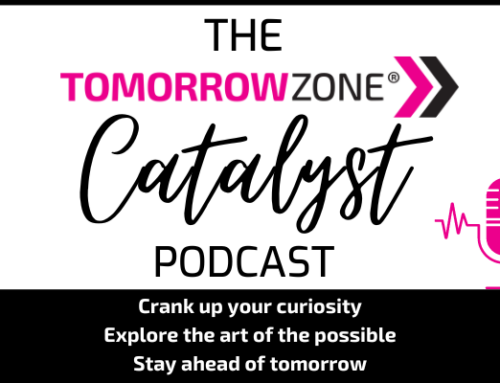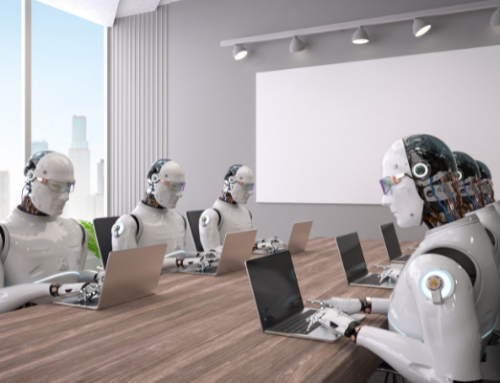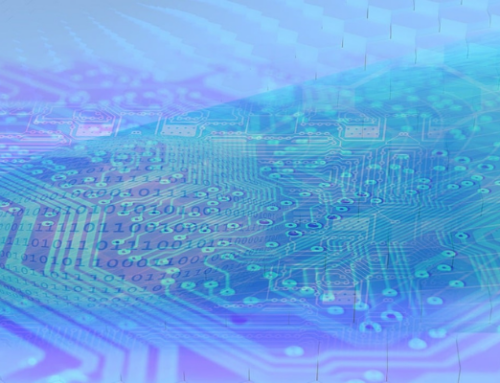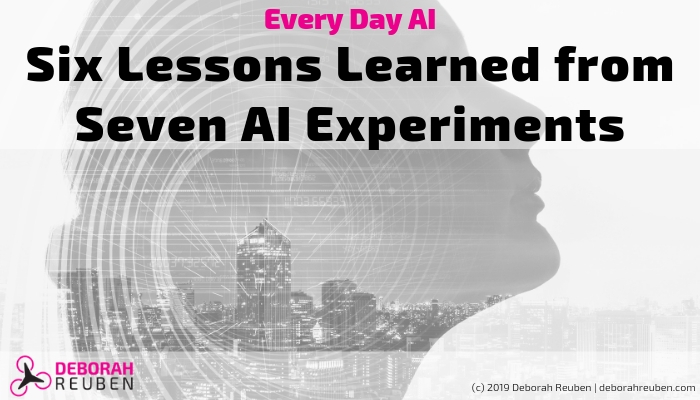
Over the past three years, I tried out multiple AI-enabled applications to increase productivity and save time. The following blog posts summarize the results for each of the seven experiments.
- Everyday AI Experiment: How Might AI Help Combat Inbox Overload?
- Everyday AI Experiment: How Might AI Assist in Web Page Design?
- Everyday AI Experiment: How Might AI Help me Brainstorm a New Logo?
- Everyday AI Experiment: How Might AI Assist in Scheduling Meetings?
- Everyday AI Experiment: Could an AI Accelerate Capturing 40 Expert Interviews?
- Everyday AI Experiment: Could AI Help Improve my Writing?
- Everyday AI Experiment: Could an AI application accelerate the process of creating presentations?
To view short presentations on each of these experiments, see my video series Everyday AI.
WHAT IS AI?
Artificial Intelligence (AI) is a loaded term, conjuring many different ideas in our imagination. As the power behind a variety of technology applications, AI has become part of our daily lives, such as the navigation app you use in your car, the smart speaker in your kitchen, or Siri on your iPhone. Any time you perform a google search, you are interacting with a form of AI.
Regardless of the technical terms, when I discuss to AI, I’m referring to the capability of machines to perform cognitive functions more typically associated with human abilities. The great advantage of AI is its proficiency in performing these types of complex tasks, on enormous datasets and at very high speeds. Following, are some examples of innovations that fall under the AI umbrella:
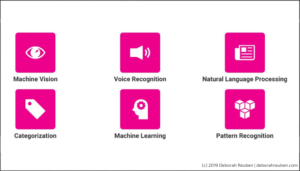
In every technology category, AI is accelerating innovation. For example, recent advances in self-driving cars are made possible—because of AI. Businesses are increasing productivity by utilizing AI to automate repetitive tasks, generate new insights, and change how work gets done. Commercial finance has even begun to utilize the application of AI to automate their legal process.
A couple of years ago, JP Morgan Chase built their own AI, called COIN (short for Contract Intelligence), to review and interpret commercial finance contract documents. COIN was able to complete, in a matter of seconds, what previously required the work of a team of legal staff and 350,000 hours over the course of a year. Not only did this automation yield significant time savings and free up legal staff to focus on more important work, but COIN enabled a decrease in the number of errors stemming from human interpretation.
Often, when one thinks of “AI”, an image ensues of a robot or something seen in sci-fi movies. For many, this can even feel intimidating. Nobody wants to worry their career will one day be replaced by a machine. When I speak of AI and how it relates to Equipment Leasing & Finance, I’m referring to narrow AI, not some sentient machine or Skynet from the movie Terminator.
Today, leveraging this technology is about narrowly applied AI: the ability of machines to handle tasks in a manner that replicates—or even surpasses—human intelligence, harnessing the ability to perform these cognitive tasks consistently and at high speed.
With this in mind, I set out to determine how I could apply narrow AI to my own business life. Before my experimental journey, the extent of my daily interaction with AI was saying something like, “Hey Siri, set a timer for 15 minutes.” Quickly, I moved on from that, discovering that AI capabilities are not just for big companies with deep pockets and an army of technologists like JP Morgan Chase.
REFRAMING MY QUESTIONS
When thinking about AI, one question plagues the mind of many: “Will AI take my job?”
As a consultant, I gave this serious thought. Is it possible for an AI to take my job? When considering the exponential pace of AI advances, I believe it could be possible someday…but it’s unlikely to happen any time soon. So, I reframed the question. Instead of asking “Could an AI take my job” I questioned, “Could an AI take the parts of my job that I would rather not do?” Through this new frame, I found some interesting answers.
Earlier in this decade, Apple had commercials about the iPhone app store. The central message: “For whatever you want to do, there’s an app for that.” They even registered a trademark for the phrase, “There’s an app for that.”
While examining my business processes and work tasks, any time I’d find a repeatable process that I didn’t want to do, I would ask myself, “Is there an AI app for that?” This one question has led to dozens of experiments, for all sorts of tasks ranging from navigation, to transcription, to building web pages, to improving my focus and staying on top of my bookkeeping.
Experimentation Process
At first, it was a wild curiosity-fueled experiment that became systematic over time. My basic thought process:
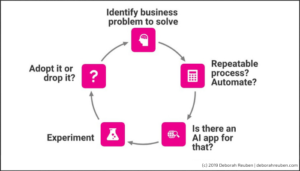
Lessons Learned
If you choose to go on a similar journey and apply this technology to your life, consider the lessons I learned along the way.
- Remember purpose. Be clear on what you are trying to accomplish. Always start with a business problem to solve, to avoid getting distracted by all the fun bells and whistles. There are many entertaining options, and it can be tempting (and time consuming) to play.
- Focus. Depending on the nature of the experiment, I’ll often set timers, or log time in my calendar, to manage my time investment in a particular trial.
- Start small and look for repeatable processes. Remember that Narrow AI applications can be a powerful productivity enhancer.
- Augmenting humans. Sometimes the AI can replace the human in a process; more often, the AI increases the human’s ability to perform.
- It’s not an answer to everything. Some experiments will lead to dropping the app. For example, I tried an AI-enabled meal planning solution, and it was impressive in its ability to generate a menu plan with recipes tailored to my dietary requirements. However, I was not willing to invest the time needed to update the data required for the AI to do this job for me. Until there is some way for my pantry to talk directly to the AI; for me, the manual process is more efficient. It doesn’t hurt to ask the question and try something out.
- Value productivity over cool tech accessories. It’s fun to be able to say, “hey, I have an AI for that.” Focus on adding value. If you can’t practically adopt the tool to your workstyle, you won’t get value from it.
Conclusion
Application of narrow AI tools can free up time so that you can focus on other things.
When we leverage narrow AI to augment what we do, it gives us superhuman productivity. It enhances human performance, without replacing the human. Many of the examples you’ll see from my experiments are not replacing me, but amplifying my capabilities, by learning to collaborate with machine intelligence.
Using a variety of AI enabled tools sparks new ideas. For me, it opened my mind to new possibilities and challenged my assumptions about where human intelligence is required, especially when it comes to creative tasks.
The following series of posts summarize the results of seven of my AI experiments, conducted over the past three years. In the end, I found there are many uses of AI that enhance daily life. Numerous apps I experimented with became part of daily work. I hope you’re inspired to try some experiments for yourself. If you do, reach out and let me know what you learn.

